The Pulsar we wanted many years ago is finally here and available at a great price
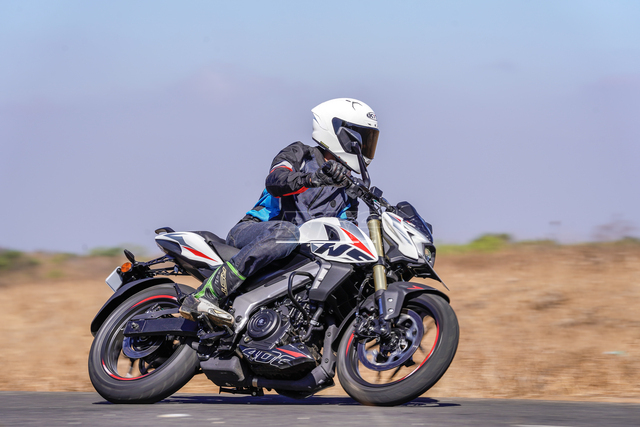
Indian motorcycle manufacturers are being accepted globally; a matter of pride for all of us. Bajaj are one of the biggest contributors to the cause and following the journey of their Pulsar range has been nothing short of endearing. We found ourselves face-to-face with the biggest Pulsar yet and it seems fitting that it slots into the NS range. Back when the NS200 was launched, our editor had suggested that the chassis was capable of handling more power. It has taken longer than we expected, but it is finally here and it is called the NS400Z wherein the “Z” hints that more products will join the line-up in the future. We had a few hours to experience it on the road and on the track. Here’s how that went.

The NS400Z is a product of smart engineering because it derives heavily from the Dominar 400 and NS200. Styling, for example, is largely based on the latter. The most significant change on that front is the headlight which features a new design for the daytime running lights (DRL) and an LED projector. Changes have been made to the contours of the cowls on the side due to a larger radiator. Personally, I feel the NS200 looked more aggressive when viewed head-on but from all other angles, both motorcycles are largely similar. They also share the same 12-litre fuel-tank. Having 17-inch wheels comes as no surprise for the NS.
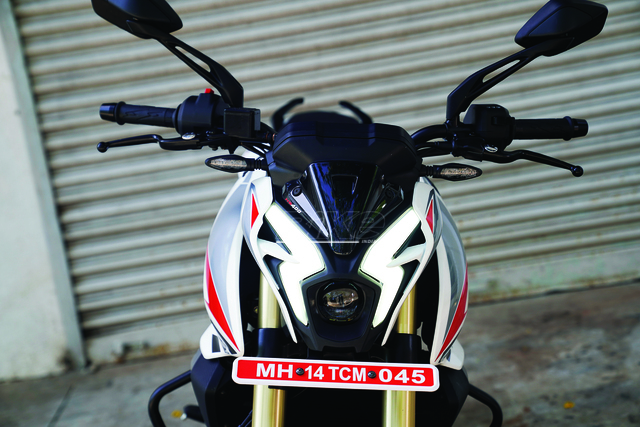
Once in the saddle, it would have been impossible to tell the NS400Z apart from the NS200 had it not been for the instrument console and handlebar. The former is a fully digital unit that also features music controls and turn-by-turn navigation. It gets the job done with no extra frills and is slightly challenging to read under harsh sunlight; a minor niggle, at best. The handlebar is now a shapely single-piece unit that adds to the naked street-fighter appeal. Bajaj have offered a switch on the right-hand side to turn the headlight on and off, which I find thoughtful. On the left side, there are more switches to navigate through the menu.

Handlebar apart, the rest of the rider triangle is largely reminiscent of the NS200’s. Following 50-plus kilometres of highway riding and a few laps on the track, I am happy to report that this is a comfortable motorcycle to spend time on. For longer rides, a plusher seat padding can make a world of difference, though.
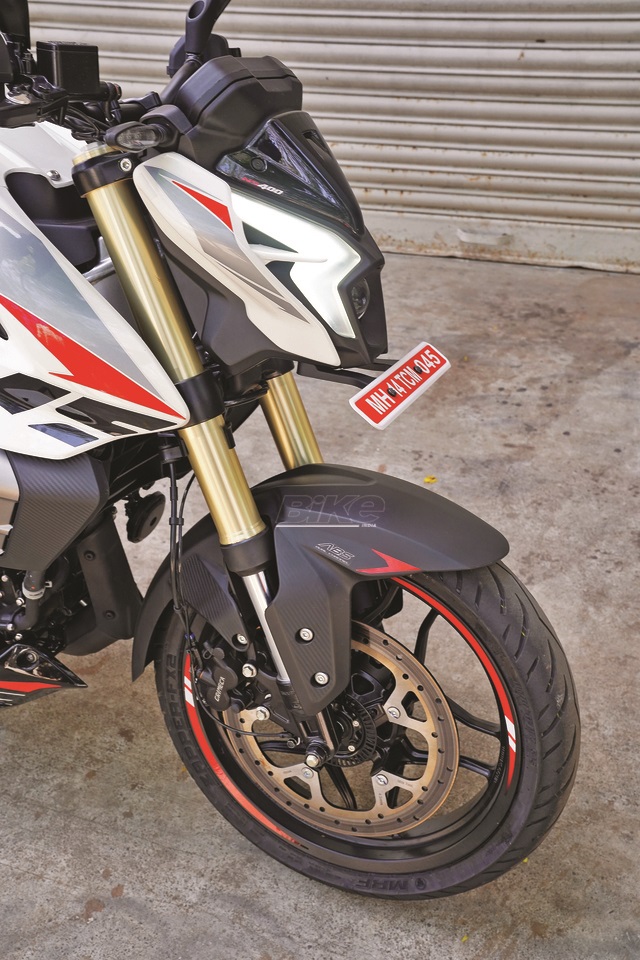
Not much needs to be said about the engine and the frame because they are straight from the Dominar 400. The perimeter frame was reinforced to take the 373-cc, liquid-cooled, DOHC, single-cylinder engine which now uses a single spark-plug instead of three. Power figures continue to be the same 40 hp and 35 Nm. However, the former arrives earlier at 8,500 rpm while peak torque arrives later at 7,000 rpm. Transmission duties are managed by a six-speed unit but the NS400Z’s final drive gearing is slightly shorter than the Dominar’s because of the 46-tooth sprocket at the rear for the Pulsar.
It does make a significant difference to the way the NS400Z behaves but there is more to it. At 174 kilograms, it is a considerably lighter motorcycle and the power-to-weight ratio has improved as compared to the Dominar’s. The engine revs freely and is eager to pull away in each gear but not aggressively so. The ride-by-wire further aids a smooth throttle input. What we get is a motorcycle that is as happy to rev through each gear as it is to be ridden around at a leisurely pace. In sixth gear, it pulls away without fuss from as low as 50 km/h. For sensible everyday riding, Road mode is adequate while Sport is apt for those seeking some thrill around corners on quiet roads. There are Off-road and Rain modes, too, wherein the responses are subtle in comparison.
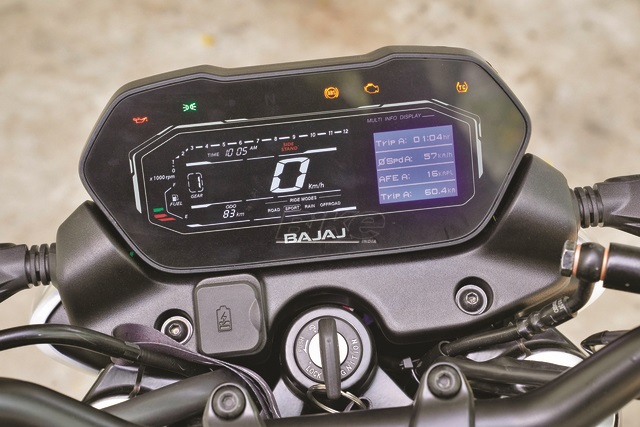
Neutral is the best way to describe this motorcycle’s handling; it complies with the rider’s demands rather than forcing him/her to do anything. It has a wheelbase that is 20 millimetres shorter than that of the NS200 due to a sharper rake angle. The turn-ins are quick but not unsettling and the motorcycle holds itself well around a corner. I must point out that although the swing-arm may look similar to its smaller sibling’s, this one is a larger 70-section unit. As for long highway rides, there is not much to complain about this motorcycle’s stability in a straight line either. Otherwise, it may have been worrisome on the back straight of Bajaj’s test-track. For what it is worth, we saw an indicated top speed of 170 km/h on the console.
The suspension equipment is from Endurance and they have set it up reasonably. It rides well on the road and is capable on the track too. Grimeca calipers bite on discs at either end. Their feedback and bite are adequate for this motorcycle’s capabilities. The same can be said for the MRF tyres too. If pushed far enough, some riders may scrape the foot-pegs and even the belly-pan but the rubber continues to do its job well. However, I don’t see this happening to most people who ride on the road.
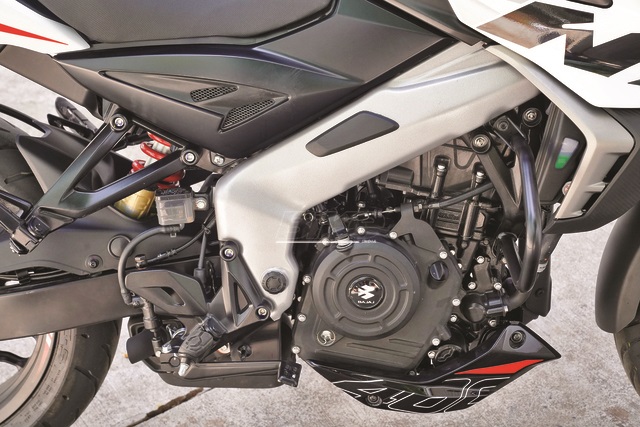
There is not much to say about quality because Bajaj gave us pre-production motorcycles with the assurance that the motorcycles that would reach showrooms later would be better. So, when you go take a test-ride, in addition to checking the quality, also check the refinement levels. Vibrations were felt between 3,000 and 4,000 rpm and past 7,000 rpm. While there is nothing surprising about the latter, the former did annoy me while chugging about at low speeds. Provided it lives up to expectations on those fronts, I must say that this Pulsar is supreme value for money. Getting a 373-cc motorcycle for Rs 1.85 lakh (introductory, ex-showroom) is tempting, regardless of how one looks at it. Furthermore, the way it is set up allows it to cater to a large spectrum of riders. The Bajaj Pulsar NS400Z has something for every rider and, at that price, a lot of motorcyclists shopping in the 250-cc segment are also going to stop and consider.
Full video review:
Also Read: Bajaj Pulsar N250 2024 Review


Leave a Reply